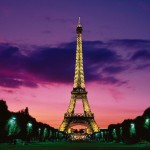Why Paris Trumps Washington
 Our capital city, Washington D.C., is a second-tier, second-rate city. And the country is better off for it.
Our capital city, Washington D.C., is a second-tier, second-rate city. And the country is better off for it.
I disagree with Rachel Ryan. Quite simply, Paris trumps Washington, D.C. Paris is a bigger, more interesting, and more significant city than the American seat of government. And that’s a good thing for the United States.
Yes, Washington, D.C. is a more interesting place than any other purpose-built national capital of recent vintage (although Brasilia, Ottawa, and Canberra are pretty weak competition), it’s far from the most important city in the United States. In many ways, it remains a provincial town: it lacks a truly great research university, a first-rate theater scene, or a single in-town restaurant that’s achieved the highest rating from any of the national guides. Unless one counts the quasi-governmental, more-or-less bankrupt Fannie Mae, not a single significant private corporation has its headquarters in the city. For a taste of the cosmopolitan commercial diversity that characterizes a true world city, one is better off in the strip malls of Fairfax and Montgomery Counties than D.C.’s urban core.
Like London, Toronto, Tokyo, Berlin, and Moscow, on the other hand, Paris is the “everything” city of its country. It’s the top tourist destination, the place where political decisions get made, the cultural capital, the financial capital, home to the best-known universities, the largest city, and the corporate headquarters town. It has the top fashion houses and the very best restaurants. Sure, some exceptions to this uni-polarity exist—The UK’s two best-known universities are each about fifty miles from London, most top German financial firms are in Frankfurt, Canada’s parliament is in Ottawa—but it remains a fact that most other developed countries can claim one city as the center of just about everything.
The U.S. is distinctly different. Boston is the country’s higher education center. New York has Wall Street and is the largest city. Hollywood produces much of the nation’s common culture. Technological innovation comes out of Silicon Valley. Chicago is the transportation and logistics hub. Orlando has the biggest single tourist attraction. Las Vegas has the best restaurants. The single largest company is in Arkansas. And so on. (Any quarrels with the above list—“Route 128 outside of Boston is more important than Silicon Valley, Atlanta’s airport is busier than Chicago’s, what about the Bay Area?”—simply prove how multi-centric the United States is.)
Only a little more than 1 percent of the U.S. population lives in Washington, D.C. and its immediate suburbs whereas nearly 20 percent of France lives in the Ile-de-France region around Paris. Even with Washington’s increasing economic control of American life, major centers of economic and cultural power lie far, far beyond the beltway and much of the country remains blessedly untouched by the political hurly-burly. D.C. is a second-tier, second-rate city. And the country is better off for it.